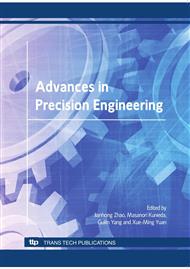p.263
p.268
p.272
p.277
p.282
p.287
p.292
p.297
p.301
Performance of Bunched-Electrode in EDM
Abstract:
This paper aims to introduce the performance of bunched-electrode for die-sinking EDM. Bunched-electrode was formed by bunching numerous hollow cell-electrodes together to generate an electrode in which end surface matches the final surface of the mould cavity. FEM analysis and experiments were conducted to demonstrate the feasibility and effectiveness of bunched electrode in ED machining. Experiments show that while machining with bunched-electrode, it is feasible to apply a much higher peak current to achieve higher MRR. Meanwhile, a special phenomenon called shallow radial craters in machining with bunched-electrodes was observed and analyzed. One possible reason may be that the plasma columns in the gap are distorted outwards by strong inner pressure flushing.
Info:
Periodical:
Pages:
282-286
Citation:
Online since:
September 2010
Authors:
Keywords:
Price:
Сopyright:
© 2010 Trans Tech Publications Ltd. All Rights Reserved
Share:
Citation:


